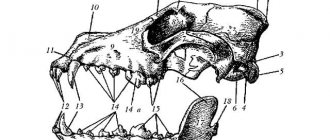Nowadays, the German Shepherd is a breed that can always protect and save from danger.
These are loyal and devoted dogs.
They also get along well with children.
They maintain excellent relationships with other pets.
Having and properly raising such a dog means finding a good friend and companion who will not leave you in difficult times.
The breed is suitable not only for protection and protection, but also for the family.
Let's find out about everything in detail.
Anatomy of the ear and what time should the ears “stand up”
At birth, the puppy's ears are not yet formed.
They are soft cartilage adjacent to the head. This cartilage is the dog's ear.
Over time, as the puppy begins to grow, the ear becomes stronger and increases in volume . As the dog grows, the cartilage will turn into an elastic plate that lacks blood vessels.
The cartilage plate is covered on both sides with a layer of connective tissue - this is the perichondrium. It ensures the development of the underlying cartilage.
The perichondrium contains many small vessels and capillaries.
They help the necessary substances needed for growth and strengthening to enter the cartilage. This is how the ear becomes: stem cells, like bricks, build the stem part of the cartilage.
Cartilage cells produce collagen and elastin . The strength of the ear depends on these substances.
When do your ears stand up?
Many people notice that small German Shepherd puppies often have ears much larger than their heads. This is due to the active work of all parts of the auricle.
From 2 months to 4 months, cartilage cells actively produce collagen and elastin, so the ear grows quickly, outpacing the dog’s overall development . The ear grows and develops throughout the puppy's first period of growth, when it becomes larger in size, but the ears still remain drooping.
The formation of ears is directly related to the change of teeth in a shepherd dog. Because of this, the ears may stand up at 2 months and then suddenly fall off at 3 months. Nothing can be done about this; these are the characteristics of the German Shepherd’s body.
After 4 months, the production of substances by cartilage decreases . By five months, the superstructure of stem cells practically disappears - the structure of the auricle reaches a certain density. The dog’s ear seems to stop growing, takes shape and is already “standing”.
CAREFULLY!
Don't be scared, because it happens that ears stand up 1-1.5 months later.
A cause for alarm is if the dog is already 8-10 months old and the ears are still hanging.
Many people take care of their puppy’s ears almost from birth, but this is still a short period of time to establish them..
It must be remembered that each dog develops individually, so you should not terrorize your baby with endless examinations. It's better to just enjoy his growing up and ensure his healthy condition.
Prevention of formation
In order for a puppy’s ears to stand up on time, it is necessary that the body receives all the necessary vitamins and minerals.:
- Add bone meal, fish and kefir to your dog's diet;
- Massage the auricle - this will ensure proper blood circulation and strengthen the cartilage;
- Sudden sounds that need to be made will help. The ear will strain and stand up.
- Monitor the health of the ear and if there are any abnormalities (irritation, redness), take your dog to the veterinarian.
What to do and how to position your ears
In situations where a puppy’s ears are not yet erect at 6-7 months, you need to know what to do and how to position the ears at home. However, before taking any measures on your own, you should consult a veterinarian.
Having found the cause in nutritional errors, he will prescribe vitamin and mineral complexes, including calcium, phosphorus, iodine, iron, magnesium and other trace elements.
Important! Drugs should be selected taking into account the age, body weight and hormonal levels of the puppy.
The doctor also determines the exact dosage and duration of treatment. You should know that an excess of active substances has a more detrimental effect on the animal’s body than their deficiency. Therefore, uncontrolled feeding of “harmless vitamins” can lead to the development of serious pathologies of internal organs. Also in the puppy's menu it is necessary to include rich bone broths, meat and bone meal, fish oil and gelatin.
In addition to changing the diet, the veterinarian may prescribe ear massage, which does not require special skills, but helps to effectively increase blood flow to the cartilage.
To perform it, you need to lightly pinch the tip of the ear with your thumb and index finger, and knead it, gradually moving towards the base. The very base of the ear should not be touched.
The duration of the procedure is from 3 to 5 minutes for each ear, with a frequency of 3-4 times a day. In most cases, a positive result appears within 2-3 weeks.
Why don't they get up?
A puppy's ears may not stand up for various reasons.
The most important thing is to go to the veterinary clinic on time. There the doctor, after asking you a few questions, will find out the reason for this phenomenon.
The most common reasons why ears do not stand up:
- Birth injuries to the ears of a puppy;
- Ear diseases;
- Allergic reactions;
- Diseases suffered by the dog;
- Conditions of detention;
- Does he get enough attention and walks?
- Do you use bio-fertilizers and which ones?
- Hormonal disorders in pet parents;
- Do you keep track of the puppy's height and weight and their relationship relative to age;
- The dog has suffered a serious stressful situation, which is why it cannot return to normal;
- The puppy's parents also had problems with ear placement;
- Perhaps this is a reaction to a recent vaccination, or, conversely, you missed a vaccination and the puppy’s immunity is struggling with some disease.
When a shepherd's ears go up
The period of setting the ears lasts from two months to almost six months. This is a moment of especially active growth of the dog, when muscle tissue increases, and most importantly, bones are stretched and strengthened. The tissues of a shepherd’s ears are cartilaginous, which is what determines their “standing up”.
The German Shepherd's ears rise gradually as the cartilage tissue strengthens. Therefore, already at 3-4 months they should not hang like soft rags. Even if the setting is not yet complete, the ears should be properly strengthened and ready for it.
Good development of cartilage tissue is an indicator of proper growth of other tissues, normal development of the dog and proper nutrition. If your German Shepherd's ears are soft, there may be a lack of essential nutrients in the diet. In this case, it is worth adding special vitamins and additives that strengthen tissues to the dog’s regular food. You can find many such drugs on sale. Or you can add just purified crushed chalk in small portions - this is an excellent source of calcium, which is responsible for the growth and strength of bone tissue.
What to do about it?
The very first and most important thing is to contact a veterinarian . Only he will be able to understand this situation by finding out the source of the problem. But there are a large number of ways to help your dog’s ears get stronger and stand up. They also need to be agreed with your doctor.
Most experts are inclined to believe that if a dog’s ears have not risen by 8 months, then this will no longer happen. In this case, an operation to install implants is performed.
The problem will not be eliminated, but the dog will meet the standard . This will allow him to participate in exhibitions.
Remember that there is no 100% guarantee that your puppy's ears will stand up naturally.
Expert opinion
Kozhevin Semyon Kirillovich
Expert dog handler.
“We rarely go to clinics with this problem - they won’t tell us anything that we don’t already know. Basically, if after 4 months there is no progress, then everyone immediately resorts to radical methods. This is not always correct; first you need to try gentle ones. In most cases they help. And immediately grasping for the most frankly inhumane methods means harming the dog in the first place.”
Staging methods
There is a method that breeders and specialists call “reeling”.
You will need large foam rollers or alternatively a small insulating tube, white surgical tape, medical glue, non-sharpened pencils, a popsicle stick (or any other):
- Remove the central axis from the curler and insert a pencil 2 cm deep into the hole. Treat the surface of the curler with medical glue.
- Insert the curler into the puppy's ear so as not to damage or block the ear canal. They can be pressed lightly so that the surface of the ear sticks to the glue.
- Cover the ear with the curlers with a plaster. Do this while holding the pencil. Wrap in a circle, starting from the bottom. It is important to not do this too tightly so as not to harm the puppy or cut off blood circulation in the ear. Just before the end of the process, remove the pencil from the curler.
- Stabilize taped ears. To do this, place a popsicle stick on the back of your ears and secure it. The stick will keep your ears erect.
- Distract your puppy so he doesn't remove the wrap.
- Keep the wrap on your ears for 10-14 days.
Even if the puppy does not have only one ear, you need to wrap both.
Another way is to make sure your puppy gets enough calcium. To do this, give him one tablespoon of cottage cheese or yogurt for each feeding.
But you should not buy or give calcium supplements to your puppy. The excess will be deposited in the bones, which can lead to problems in the future.
What to do?
If your dog is more than six months old and his ears are still drooping, then they will have to be rewound. Before the procedure, be sure to consult a specialist.
It is important not to tape your dog's ears until he is six months old. Too early a procedure can cause damage to the ear.
Rewind
First you need to purchase materials. What you need for rewinding:
- large foam rollers;
- white surgical plaster in a spool;
- medical glue (preferably special dog glue, sold in veterinary pharmacies);
- wooden stick for fixing ears.
When everything you need has already been purchased, proceed to the procedure. Make sure everything is sterile and wash your hands thoroughly. The dog must be calm. The procedure is as follows:
- Wipe your puppy's ears with an antiseptic.
- Take curlers. Take the center out of them, leaving only the foam base. Take a pencil and insert it into the hole with the eraser first, but not all the way. The pencil is needed for stabilization; it will then need to be removed.
- Apply medical glue to the outside of the curler. Make sure there is not too much glue so that it does not get into the ear canal.
- Place your ear in a vertical position and attach curlers to the hanging part. Leave some distance between the edge of the curler and the dog's head so as not to close the ear canal. Apply a little pressure to your ear so that the curler can secure itself.
- While holding the pencil, wrap a bandage around your puppy's ear. Do not attach the patch too tightly so as not to cause discomfort to your pet. When it's all over, put the pencil away.
- Attach a wooden stick to the back of the ear. This will secure the ears in a standing position.
- After all the steps, it will take about 5-7 minutes for the patch to attach. Distract your puppy during this time: feed him a treat or play.
The patch is worn for 10-14 days.
Alternative way
Alternative ear fixation:
- Gently feel your dog's ears for weak cartilage. When you find one, the ears will immediately straighten.
- Cut a piece of cardboard slightly larger than the problematic cartilage.
- Disinfect your puppy's ears. Take an adhesive plaster and stick it on the weak cartilage. Lubricate a piece of cardboard with medical glue. Stick it on the plaster, then secure it with the 2nd layer of plaster.
Breeders and veterinarians prefer the first method. But if you don’t like it, the right to choose remains yours.
The most gentle way
One of the methods for setting up ears is gluing. To do this, you must first identify the weak points in the auricle.
If they are located in the lower or upper part of the ear, then you cannot do without it:
- Prepare two pieces of cardboard that will be slightly larger than the weak point, cut off a piece of adhesive tape.
- Plug the dog's ear canal with cotton wool, then shave the area where you will glue the cardboard. Treat the area that had to be cut. Treat the sticky side of the patch as well - this is necessary so that when peeling it off you do not damage the sink. Wait for it to dry and stick the patch on. Press it to your ear and smooth it out.
- Next, take a piece of cardboard, grease it and the patch in the ear with Moment glue or another quick-drying glue. Holding the ear, glue the cardboard. Then secure it with a second piece of tape.
- If this procedure is required on the second ear, then repeat it in the same way.
- Keep the patch on your ears for 1-2 weeks.
What to do if your ears don't stand up?
If your German Shepherd is six months old and his shells are hanging, consult a veterinarian or an experienced dog trainer. Diet correction is necessary, however, physiotherapeutic actions will also be required. Clean your ears regularly, get all the necessary vaccinations, and get rid of worms quarterly. See the article on how often to worm puppies.
Give your pet toys to chew on. This is how the jaw muscles and the adjacent muscles of the auricle develop. Carry out diagnostics. Feel the ear, find a relaxed place in it. It has the shape of a spot and, if located in the upper part, the prognosis is favorable. Give your pet a light massage to activate local blood circulation and wait for the ear to heal on its own.
If the weak point is located at the bottom of the sink, you will have to build a structure to support the sink.
Watch the video:
We will consider the process of ear installation in more detail in the next section.
What to do after?
Once your dog's ears have stood up, you need to prevent them from falling back. And this may well happen if you, overjoyed, stop paying attention to this problem.
You need to keep your ears upright.
To do this, tense your dog's ears with loud sounds as often as possible, without trying to scare him. Call her, call her by name, give commands. Do everything to keep the ear pinna tense most of the time.
NOTE!
Also examine your ears for any weak spots so you don’t miss a moment and do the gluing in time.
A massage of the ears will not hurt, as it will disperse the blood over the entire surface of the ear.
Reasons why ears don't stand up
Veterinary experts identify several reasons why German Shepherds' ears do not stand up.
- A genetically determined anomaly, inherited from parents.
- Insufficient intake of calcium, phosphorus and some other minerals.
- Overfeeding and excess weight inhibit the absorption of essential microelements and nutrients.
- Hormonal disorders.
- Low physical activity leads to insufficient blood flow to organs and tissues, inhibiting the synthesis of new cells and the formation of dense cartilage.
- A defect in the development of the cartilage plate, expressed in its inability to support the ear vertically. The cartilage acquires a heterogeneous structure, in which dense areas alternate with softened tissues. At their junction, scars and creases form that do not allow the auricle to rise.
- Frequent or severe stress, during which cortisone is produced. This anti-stress hormone helps slow blood flow, accelerates the leaching of calcium from the body, and blocks the synthesis of new cells.
- Improper conditions of detention. Severe overheating in summer and hypothermia of the ears in the cold season provokes spasm of blood vessels, slowing down the flow of minerals and vitamins to cartilaginous tissues.
- Past infectious diseases, otitis, otodectosis or piroplasmosis.
- Presence of birth injuries to the head or hearing organs.
- Violation of the vaccination schedule.
Important! If you often stroke your puppy's head and ears, he will develop the habit of pressing his ears to his skull and laying them back. As a result, creases and scars gradually form, preventing the ears from rising to a horizontal position.











